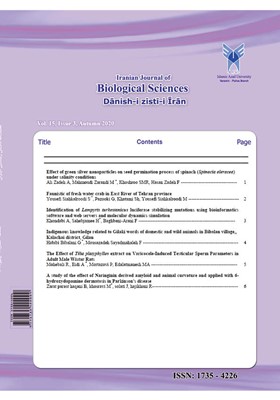A study of the effect of Naringinin derived amyloid and animal curvature and applied with 6-hydroxydopamine dermatosis in Parkinson's disease
Subject Areas : animal physiologyBAHAR haghani 1 , Maryam khosravi 2 * , jalal solati 3 , ramin haji 4
1 - Department of Physiology, Faculty of Biological Sciences, Islamic Azad University, North Tehran Branch, Tehran, Iran
2 - 1. Department of Physiology, School of biological sciences, Islamic Azad University, North Tehran Branch, Tehran, Iran
3 - Department of Physiology, Islamic Azad University of Karaj Branch, Karaj, Iran
4 - Department of Physiology, Faculty of Life Sciences, Islamic Azad University, North Tehran Branch, Tehran, Iran
Keywords: Naringenin, 6-Hydroxy dopamine, Parkinson's disease, Neuroprotective Effect,
Abstract :
Materials and Methods: In this study, the NMRI adult male mice were anesthetized. To induce the Parkinson's animal model, a 22 gauge cannula was placed into the left Substantia Nigra pars compacta and then 6-hydroxydopamine was infused to Substantia Nigra pars compacta through a 30-gauge cannula. The group control1 received saline on the left side of the Substantia Nigra pars compacta.Then, to investigate the effect of the Naringenin, group control2 received distilled water and other groups received Naringenin via gavage for two weeks, and apomorphine induced rotation, catalepsy, and behavioral tests were assessed in all groups. Hematoxylin and eosin staining was performed and the percentage of the neurons on the left side of the Substantia Nigra pars compacta were calculated. In this study, in cell culture model, dopaminergic-like neurons cultured in DMEM medium were counted, and cells were used and incubated to evaluate the effect of naringinin against 6-hydroxy dopamine. Concentrations were 50 for 6-hydroxy dopamine solution and 0.25, 0.1 and 0.01 for NAR solution. Finally, cell viability was assessed using MTT and trypan blue methods.Results: 6-Hydroxy dopamine increased catalepsy and contralateral turns compared to the control group. Naringin reduced catalapsy and contralateral turns, it reduced anxiety and depressive-like behaviours besides that it increased swimming time and locomotor activity compared to the control group. Conclusion: it seems that Naringin is a therapeutic option for neurodegenerative disorders, such as Parkinson's disease.
_||_

